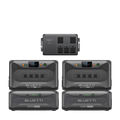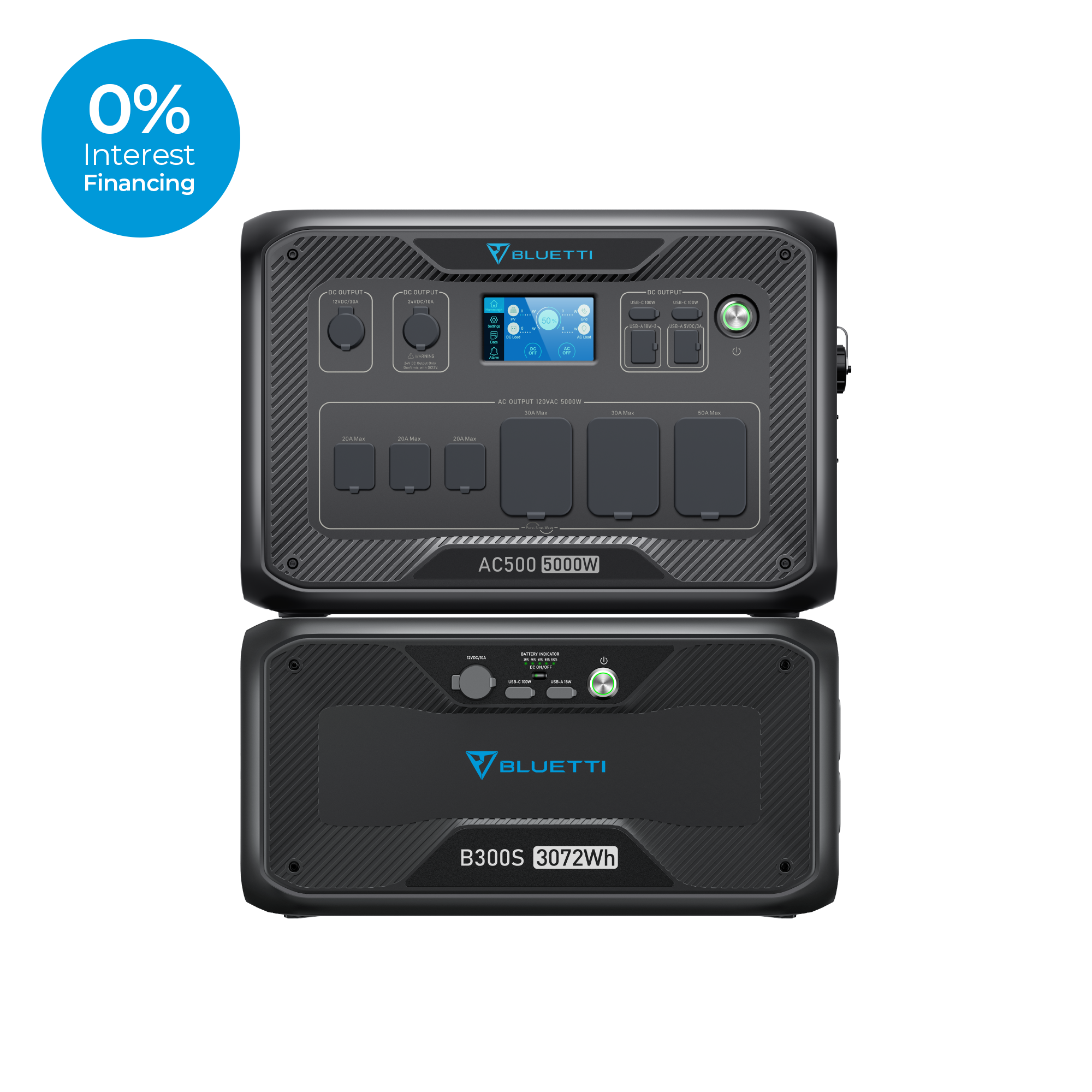Your cart is empty
Shop our productsMore and more homesteads are turning to solar-generated energy. This is because it is renewable, eco-friendly, and allows one to enjoy tax incentives. However, without batteries, you can enjoy solar power during the day.
To prevent this, you can add a battery system such as the BLUETTI B300S to enjoy renewable energy regardless of the weather conditions. Alternatively, you can use normal 12V batteries. But how do you charge a battery with solar panels? Let’s find out.
What Size of Solar Panel Do You Need to Charge a 12V Battery?
Most solar panels have a rating and power output compatible with a 12V battery. The solar panel should match the battery’s wattage, amp hours, energy consumption, and voltage requirements.
Ideally, 12V batteries come in various capacities ranging from 5 to Ah. To choose the right solar panel, you need to consider the following:
- The Ah rating of the battery
- The speed at which you need the battery charged
With these questions answered, you’ll have a rough idea of the perfect solar size. For example, if you have a 12V battery with a 120Ah capacity and a charging duration of 10 hours, you can determine the total wattage needed using the following formula:
Ah x Volts = watts (Wh)
So, for the above example, the wattage will be:
120Ah x 12V = 1440Wh
Now, to determine the solar panel size to charge the battery in 10 hours, you’ll use the following formula:
Wattage (Wh) / recharging time = solar panel wattage
1440Wh / 10 h = 144 W
As such, you’ll need a 144-watt rated solar panel or more to charge your 12V battery in 10 hours.
How to Charge a Battery from Solar Panels

While it is possible to charge a battery directly using solar panels, it is not always viable and can cause damage to the battery. To mitigate this, you need a charge controller that converts the voltage output of the panels to a level compatible with the battery.
Types of Charge Controller
MPPT(Maximum Power Point Tracking)
MPPT controllers are the most expensive and reliable. They allow you to connect numerous batteries simultaneously. In addition, it allows you to use batteries of varying voltages.
PWM(Pulse Width Modulation)
PWM controllers are also an ideal option if you are on a budget. However, the battery voltage and solar panels must match for its mechanism to work. PWM charge controllers are ideal for small solar panels.
On/Off Charge Controller
The most ideal and cheapest option to use are the on/off charge controllers. When the battery is full, it stops the flow of current from the solar to avoid damaging the battery. While they are cost-effective, they are not effective as they are 85% less effective. We recommend using the MPPT option since it is more effective.
With the controller, you can use the following methods:
The DIY Method
- Find a safe place to install the charge controller. You should mount it away from the solar panels. If possible, install the controller away from weather elements.
- Connect the battery to the controller. You’ll need negative and positive wires with ring connections for the best results. Alternatively, wrap bare wires over the battery. You can use a black wire for the negative connection and a red one for connecting to the positive part.
- Once the wires are connected to the battery, insert the black and red wires into the relevant ports on the controller. Tighten the screws for a tight fit. Ensure to insert the wires in the correct ports to avoid damaging your controller.
- With wires to the battery in place, it is time to insert input wires into the controller. These are the wires from the solar panels. You should connect them using MC4 connectors to ensure they bond properly.
- Now connect the charge controller to the solar panel. Snap the MC4 connectors into place by aligning the male and female ones with the corresponding ones from the solar panel. This is to ensure a tight fit.
- Finally, test whether the charge controller is working. Most controllers have a digital display that shows the current flowing. Others come with an app for easier monitoring. Whichever the case, ensure its functionality is in good condition.
Using MPPT Charge Controller
Another viable option is to use an MPPT charge controller. While expensive, they guarantee the safe recharging of the battery. To use an MPPT charge controller, you need to consider the following:
- Solar panel wattage: Most solar panels have a sticker showing the maximum wattage of the solar array. If your panel does not have an array, you can use a multimeter to calculate the wattage. Most solar panels with a rating of 12V usually have a maximum capacity of 17V. This is to avoid damaging the battery since it is almost impossible to reach 17V.
- Choose an MPPT charge controller: While you can use a PWM(Pulse Width Modulation) controller, the MPPT(Maximum Power Point Tracking) option is the most ideal. Besides, they store more energy compared to PWM and allow parallel operation with many solar panels.
What Batteries Can You Use with Solar Panels?
You can use either lithium-ion, lead-acid, or deep-cycle batteries with solar panels. Let’s see how each compares.
Lithium-ion Batteries
Lithium-ion batteries are the most popular options to use with solar panels. This is thanks to their effectiveness and reliability. They are also easy to charge using solar panels, with most charging within six to eight hours. In addition, they are safer, lighter, and easy to maintain.
For example, the BLUETTI AC300 Home Battery Backup has a maximum capacity of 3,072Wh which can be expanded to 12,288Wh. And with a maximum solar input of 2400W, you can rest assured it will recharge within six hours.

Like other lithium-ion batteries, it is long-lasting, offering over 10 years of service with minimal maintenance. To recharge it, you can use AC, solar, lead-acid battery, and your car. What makes this battery stand out is its fast dual-charging feature. Connecting it to an AC power source and solar provides 5400W of power.
Lead-acid Batteries
Another popular option is lead-acid batteries. They were among the first rechargeable batteries to be used with solar systems. The first lead-acid battery was developed in 1859. When sulfuric acid and lead combine, the chemical reaction produces current, powering your devices.
They are more durable than lithium-ion batteries, functioning for years before becoming ineffective. The downside? They require regular maintenance to mitigate corrosion.
Deep Cycle Batteries
Unlike lead-acid and lithium-ion batteries, deep-cycle batteries do not suffer damage regardless of the discharging cycle. They can handle repeated charging and discharging for many years, making them ideal for large solar energy systems.
While charging deep cycle batteries is similar to charging other batteries, they require more current from the panels. As such, you need to place the panels where there’s ample sunlight.
How Many Solar Panels Do You Need to Charge a 12V Battery?
Well, charging a 12V battery does not require many solar panels. But if you have multiple batteries, you might need to connect two solar panels with a max power output of 100W.
Assuming you have 12V batteries with a 100Ah capacity, you need to calculate the daily energy generation of the solar panel.
Daily energy generation (Wh) = rating (W)x daily sunlight hours (H)
Assuming you get 5 hours of full sunlight per day, the daily energy generation will be:
200W x 5h = 1000 Wh
You can now calculate how many batteries can be charged with this daily energy generation using the following formula:
No of batteries = daily energy generation (Wh) / battery capacity (Wh)
To determine battery capacity, you’ll need to multiply the battery voltage (V) by its capacity (Wh).
Using our example, this will be 12V x 100Ah = 1200Wh
So, to calculate the no of batteries, you will use this formula:
1000Wh / 1200 Wh = 0.833 batteries
That is equivalent to one battery.

The BLUETTI PV200 Solar Panel has a maximum power output of 200W. With it, you can charge an average 12V battery. Thanks to monocrystalline solar cells it has a 23.4% efficiency. With a long-lasting ETFE coating, the solar panel can last for many years.
What Types of Solar Panels Can You Use To Charge A Battery?
There are three types of solar panels you can use to charge your batteries: thin-film, polycrystalline, and monocrystalline.
Monocrystalline Solar Panels
These are the most expensive but also the most effective. This is thanks to their ingenuity which involves the creation of individual silicon crystals. This process is not only expensive but also labor-intensive.
Polycrystalline Solar Panels
Polycrystalline panels are cheaper than monocrystalline options. They are made from silicon fragments rather than silicon crystals. They are however less efficient.
Thin-film Solar Panels
Thin-film solar panels come in two types: CIGS and CdTe. The former is more expensive than CdTe. They are however cheaper than polycrystalline and monocrystalline panels. Since they are lightweight and easy to use, they are ideal for residential use.
Final Thoughts
As you can see, you can use solar panels to charge batteries. You’ll however need a charge controller to prevent damaging the battery. Using an MPPT controller is the best option as it allows for the simultaneous use of batteries.
Shop products from this article
Be the First to Know
You May Also Like

What Does a 30% Federal Solar Tax Credit Mean and How to Apply?
Governments around the world are offering programs that encourage homeowners to switch to solar energy. Among the most notable programs is the 30% Federal Solar Tax Credit. It reduces your...

Deadly Flooding Devastates U.S. South and Midwest — What You Need to Know


















































































































































































































































